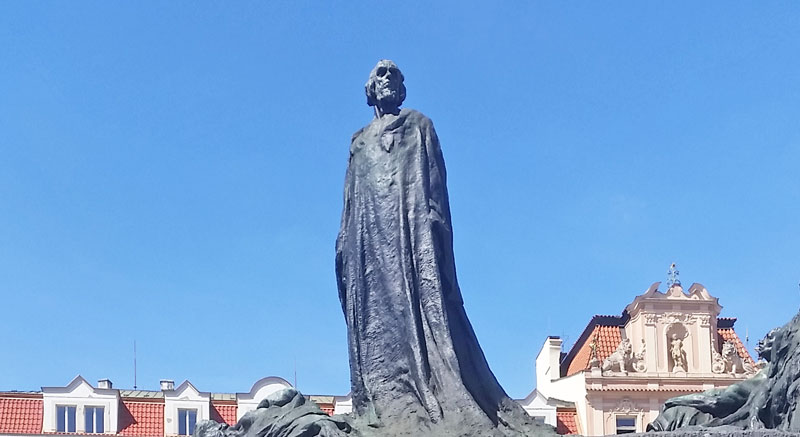Famous Czechs – Jan Hus
This will be the first of five posts which will eventually give you a rounded view of Jan Hus, how to interpret his monument, where he preached and why plus a clever piece of art. But first you should understand who he was and hence WHY he is one of the most famous Czechs.

Jan Hus Origins
Although the date of his death is well known, his birth was not so famous and historians place it at 1370 “give or take”. The name comes from the town of his birth i.e. Husinec. As he was christened Jan therefore he was known as Jan of Husinec and abbreviated to Jan Hus. He signed his name “Johnes”. His education before the age of 16 is a grey area. Nobody has ever formed a link for how, coming from a “serf” family (basically poor servants), he managed to get any kind of education. It’s thought that he may have excelled in religious study which got him a place at a larger school where he came into contact with a man called Christian of Pracatice. It was this man that invited the 16 year-old Jan Hus to study at the University of Prague.
The University of Prague (later Charles University)
Although not the best student, Jan Hus graduated with a Bachelors Degree from the Faculty of Arts in 1393 and a Masters in 1396. He was elected to be Dean of the Faculty of Arts in 1401 (one year term). By this time he was also studying Theology and received his Bachelors Degree in 1408. He did not continue is Theology studies any further as it seems there was a conflict in his beliefs.
Jan Hus as a Priest and the Reformation
Jan Hus was ordained as a Catholic Priest in 1400 and until 1408 combined his studies with the duties of being a priest at ST Michael’s Church and more significantly the Bethlehem Chapel. It’s in this period that he studies the works of John Wycliff, an English Theologian (never ordained) who died before Jan Hus even graduated. Wycliff’s writings were Utraquist i.e. they basically upheld the belief that Holy Scriptures were the word of God, but that the Pope, Papal politics and the murky world of Catholic finances was turning people against the church and therefore reformation was required. Jan Hus had to decide how closely he followed the Catholic Dogma.
The Body of Christ
Up until the early reformists like Jan Hus, the Catholic Church in Bohemia had a few strict rules. One was that all sermons were in Latin. Another was that during the Eucharist, only the wafer (body of Christ) was given i.e. not the wine (blood of Christ). Wycliff’s teachings argued that the soul of Christ could not be understood without both the body and the blood being combined. It seems that by 1402, Jan Hus was already prepared to deviate from strict dogma when he took the position of priest at the Bethlehem Chapel which was built on condition that whoever gave the services here 1) did it in the vernacular (in Czech language) and 2) “gave the chalice” (meaning to give wine at the Eucharist). Although NOT a believer in ALL of Wycliff’s teachings, as an ordained Catholic Priest, Jan Hus had clearly set himself on the path of Reformation.
Papal Authority
The period between 1403 and 1414 was a mess for the church. There was the official Pope elected at the Vatican but there were also 2 other anti-popes elected by various states. One practised official Catholic Doctrine. The others disagreed with elements of this Doctrine and were seeking a Reformed Church. The Church recognised this and the Council of Pisa tried to unite the church under one Pope but it failed. But what it did do was to start legal proceedings against known reformers of which Jan Hus was one. Jan Hus was excommunicated by the Pope in 1412 but he continued to preach at the Bethlehem Chapel because that was not a Catholic Church.
Council of Constans
A Papal Council is not a quick thing. It can go on for years. This council was actually pretty quick as it started on November 5th 1414 and ended on April 22nd 1418. It had 3 aims. 1) Papal Unification, 2) Ending Heresy and 3) Reformation.
Actually it was all about the first aim so over the next two years the Catholic Church legally aligned and gave itself the power to eliminate anybody not following their Doctrine therefore achieving a reformation of the Church and ending Heretical views. During the course of this Council, Wycliff’s teachings were officially called heresy and Jan Hus was personally identified as a heretic. He was forced to leave Prague for a year before returning and agreeing to attend the Council of Constans.
Now the legal proceedings which had started two years earlier reached their end with Wycliff’s teachings now heresy and being burned. Anybody practising those teachings were labelled as heretics and therefore right to be burned at the stake as Jan Hus was on July 6th 1415. He was commemorated in Prague with the Jan Hus Monument 500 years later and in 2015 with the unveiling of Za Pravdu.
The death of Jan Hus had far ranging implications. Quite simply by the year 1417 the Catholic Church had unified under Pope Martin V but failed to reform in any significant way. This effectively paved the way for the Hussite Wars over the next 20 years in a period called the Bohemian Reformation. By 1485 the wars were over, the Catholic Church had split the opposition and had been victorious.
Something Related or a Few Minutes Away
Attraction – Church of Our Lady Before Tyn
Attraction – Church of ST Nicholas Old Town
Art and Culture – Slav Epic Part Three
